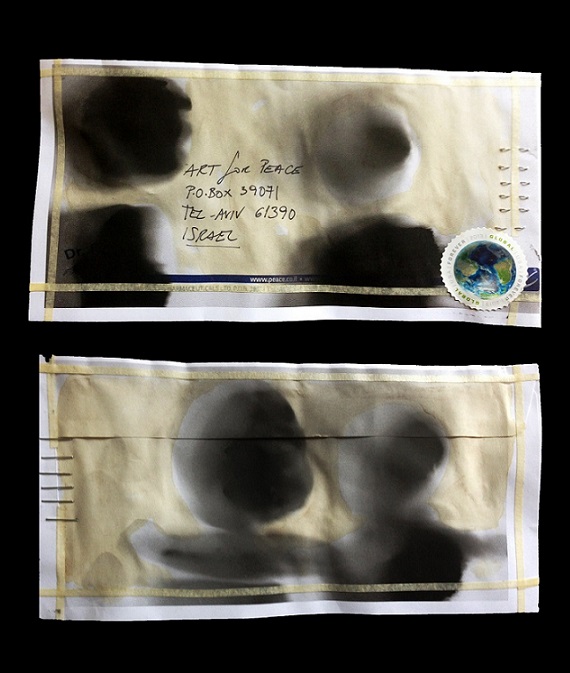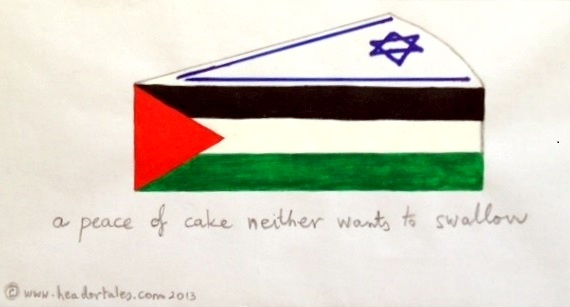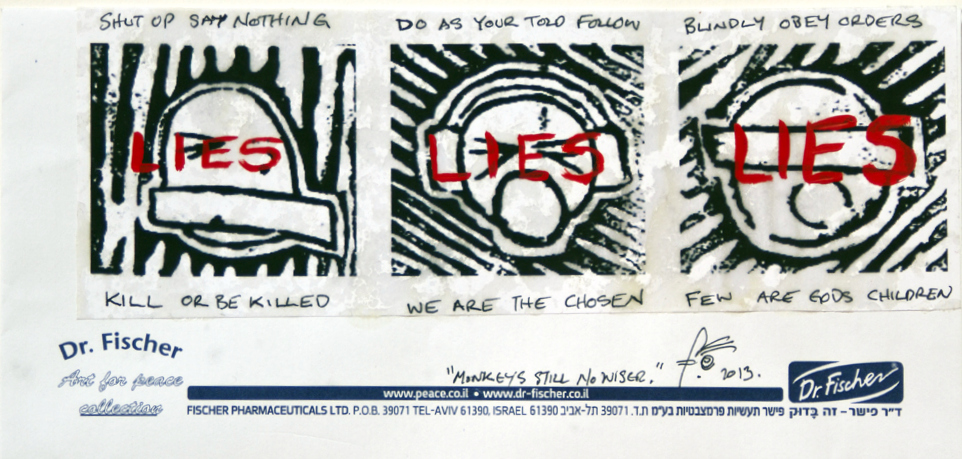 Private View Thursday 10th October from 6.30
Private View Thursday 10th October from 6.30
Dr. Fischer’s Art for Peace Collection was initiated together with the signing of the peace treaty between Israel and Egypt in 1979 and with Jordan in 1996.
300 artists from Israel and around the world were given the task of creating a painting dedicated to peace and tolerance on a regular envelop used for mailing letters. The collection is transportable and is often presented to the public due to the generosity of the Dr. Fischer company. As a result of the exhibitions, representatives from Israel and from a number of Arab states including the Palestinian Authority have had the opportunity to meet. Creative workshops are held alongside the exhibition dedicated to mutual understanding and tolerance and aimed at creating a dialog between nations. The envelopes were joined by a collection of art dealing with the topics of war and peace by leading artists. To date, the collection has been exhibited in over 50 galleries and museums worldwide.
British artists will be invited to draw, paint or write on Dr. Fischer’s peace envelopes and their work, which will be donated to the collection, will be exhibited as well.
Doron Polak / Curator, Art for Peace Collection
Amiram Eini, Avi Ezra, Avi Pines, Ben Saidman, Bracha Guy, Buthaina Milhem, Dana Nay, Daniel Baharier, David Collis, Dean Baler, Dvora Morag, Eliane Sara, Gali Timen, Gary Goldstein, Gerald Shepherd, Gil&Moti, Gillian Best Powell, Glyn Powell, Guy Shoham, Hoda Jamal, Ilana Fattal, Ilana Yaron, Karen Mcerlean, Keren Shpilsher, Khen Shish, Lawrie Simonson, Liron Alfa, Marc Lewis, Margaret Higginson, Mervyn Diese, Micha Laury, Michael Lazar, Michelle Fattal, Michel Wolman, Nadia Ghadban Kadry, Nael Kadry, Nechama Levendel, Nicola Rae, Nurit Rosen, Paul Malone, Pedro Salvadores, Rafi Baler, Rania Akel, Said Affassi, Sarah Lightman, Cecilia Mandrila, Claudia DeMonte, Shoshi Lax Perel, Sohad Dev, Tasleem Mulhall, Uri Gershuni, Yechiel Shaked
Dr. Fischer Cosmetics Company, owned by Dr. Eli Fischer, engages in beneficial voluntary activity of promoting peace mainly through art. The Fischer couple established a foundation by the name of “Art for Peace”. The foundation owns a collection of  hundreds of artworks painted by leading Israeli artists on the backs of envelops from the first day of the Peace Treaty between Israel and Egypt and Jordan. The envelops were presented at the Eretz Israel Museum in Tel Aviv and the Bezalel Academy of Art and Design in Jerusalem, as well as 50 museums and art galleries all over the world. Our exhibition will present artists from England and Israel. The exhibitions are mobile and significant mainly due to the discussions and activities which follow them.
hundreds of artworks painted by leading Israeli artists on the backs of envelops from the first day of the Peace Treaty between Israel and Egypt and Jordan. The envelops were presented at the Eretz Israel Museum in Tel Aviv and the Bezalel Academy of Art and Design in Jerusalem, as well as 50 museums and art galleries all over the world. Our exhibition will present artists from England and Israel. The exhibitions are mobile and significant mainly due to the discussions and activities which follow them.
 Painting on postal envelops is not a new thing at all. Authors and poets have designed, create and wrote literary and artistic works which were inspired by letters or postcards. Postal envelops, and the letters inside them, stirred the imagination of many artists during the long world cultural history, and they used them for their artistic purposes which created the powerful current of “Mail Art” .A letter inside an envelop, whose content is unknown, was a sensual mysterious enigma which exited artists and helped them create moving works of art in words and colors.
Painting on postal envelops is not a new thing at all. Authors and poets have designed, create and wrote literary and artistic works which were inspired by letters or postcards. Postal envelops, and the letters inside them, stirred the imagination of many artists during the long world cultural history, and they used them for their artistic purposes which created the powerful current of “Mail Art” .A letter inside an envelop, whose content is unknown, was a sensual mysterious enigma which exited artists and helped them create moving works of art in words and colors.
We chose to present the envelop exhibition within an urban bubble of the “coffee shop – gallery”. What is there in the coffee shop which makes the people sitting there feel as though they are in a bubble? Is the relocation of the ancient, tribal coffee ritual to the public sphere one of the causes of this bubbly sensation? Or is it the coffee which excites the spirit?! And maybe the combination of the two.
The drinking of coffee raised, in more ways than one, a public debate since the Middle Ages on the morality of its use due to the arousing effect of caffeine. At certain times its drinking was even banned by royal decree. In Turkey coffee drinkers were threatened with the death penalty. Islam considered it as a real threat and Christians believed that that the devil used it to trap its believers. The Mormons – the believers of a Christian movement which looked for a new way of worship – prohibit the drinking of coffee even today. Coffee caused religious and political debates, and is still the subject of medical studies.
Many coffee shops appeared in the cities of Europe during the 17th century. And in the 1920s and 1930s coffee shops were the second home of intellectuals, writes, poets, actors, journalists and politicians which turned the coffee shops into the pounding pulse of the urban landscape. Some of them became real institutions such as the “Cabaret Voltaire” in Zurich where the Dada artists used to meet, and the “literary” coffee shops in Paris: “Café de flore” and “La Coupole and La Dome”, and in Israel the famous literary coffee shops of Kassit, Ravel, California and Kapulsky. In these coffee shops we can still see today the painted and written testimonies of leading artists and authors which left an indelible cultural mark.
Letter envelopes which were pulled out of pockets served as the intimate background on which paintings were drawn and love words were written – which testify to the romantic and commercial connections that were created around the coffee shop table. Coffee stains and leftovers of cakes and pastries shaped and turned them into a sensual and exciting document.
Nowadays when the traditional coffee ritual has disappeared in modern society, coffee shops, belonging to the huge coffee industry which is considered the second largest industry after oil, serve as a proper alternative with ritualistic traits of its own. The space design, location, concept, hosting staff and visiting crowd, all these components, are important starting points for creating an atmosphere which will make a pleasant stay for the guests who choose to meet in this rather than any other place.
The phrase “meet you for a cup of coffee” became in modern affluent society an invitation to negotiations in an amicable spirit. Even when the circumstances are sometimes are rather unpleasant – the meeting for coffee always entails the option of reaching a compromise. But in most cases the circumstances are pleasant and people choose to be in the bubble from their own free will.
Artists from Israel and England left an artistic mark on the postal envelop with thread and needle, colors, textiles, glue and paper. And thus they created an artistic statement – a tribute to the mythological postal envelops.
The power of the letter and its content is sometimes indescribable. As a person and a mother I would like to share with you a touching story from the fascinating biography of the author, combat pilot, diplomat and movie director Romain Gary, who in his autobiographical book Promise at Dawn tells about his powerful connection with his mother – the most significant woman in his life, who for years used to send him letters every day when he served as a combat pilot and was away from his home and from her. She did so faithfully in order to uplift his spirit. The mother’s letters strengthened him and calmed his turbulent soul. After the war ended he rushed to his home and his mother to discover the inconceivable truth. His mother had been dead for years. Before her death she wrote hundreds of letters for her son and gave them to a friend with clear instructions what to do with them. Gary continued to receive his mothers healing letters, every day, while she was no longer alive.
Quote: “During the last days before her death, she wrote about two hundred and fifty letters she sent to her friend in Switzerland. I was not allowed to know that she would no longer be able to comfort me – the dateless letters were supposed to be sent to me at regular intervals. And she probably planned it with great love since I noticed on her face that innocent and cunning smile when we said goodbye in the hospital. And thus I continued to enjoy her strength and courage that I needed so much, until victory day. About three and a half years after her death, the umbilical cord continued to fulfill its task”. (From: Promise at Dawn by Romain Gary).
Ruth Lubin / Curator, London exhibition


